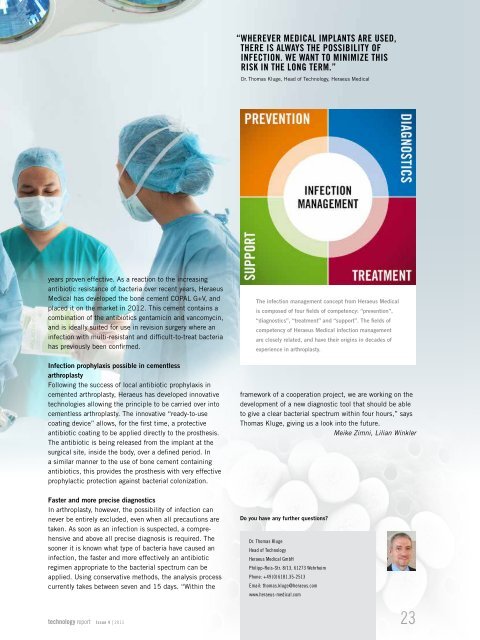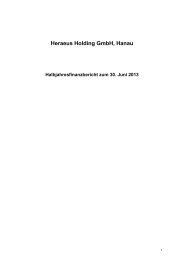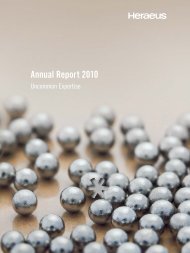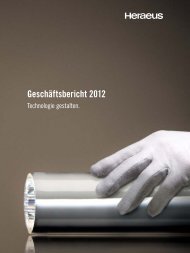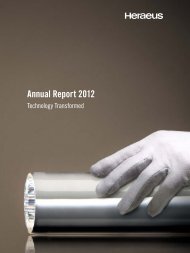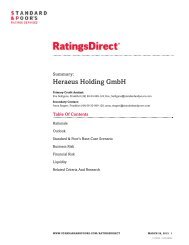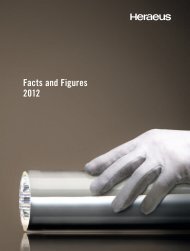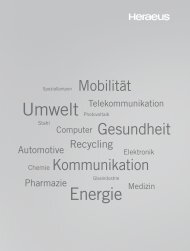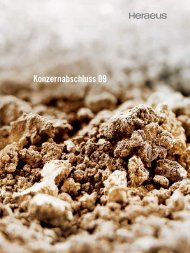technology report 04
technology report 04
technology report 04
You also want an ePaper? Increase the reach of your titles
YUMPU automatically turns print PDFs into web optimized ePapers that Google loves.
“Wherever medical implants are used,<br />
there is always the possibility of<br />
infection. We want to minimize this<br />
risk in the long term.”<br />
Dr. Thomas Kluge, Head of Technology, Heraeus Medical<br />
years proven effective. As a reaction to the increasing<br />
antibiotic resistance of bacteria over recent years, Heraeus<br />
Medical has developed the bone cement COPAL G+V, and<br />
placed it on the market in 2012. This cement contains a<br />
combination of the antibiotics gentamicin and vancomycin,<br />
and is ideally suited for use in revision surgery where an<br />
infection with multi-resistant and difficult-to-treat bacteria<br />
has previously been confirmed.<br />
Infection prophylaxis possible in cementless<br />
arthroplasty<br />
Following the success of local antibiotic prophylaxis in<br />
cemented arthroplasty, Heraeus has developed innovative<br />
technologies allowing the principle to be carried over into<br />
cementless arthroplasty. The innovative “ready-to-use<br />
coating device” allows, for the first time, a protective<br />
antibiotic coating to be applied directly to the prosthesis.<br />
The antibiotic is being released from the implant at the<br />
surgical site, inside the body, over a defined period. In<br />
a similar manner to the use of bone cement containing<br />
antibiotics, this provides the prosthesis with very effective<br />
prophylactic protection against bacterial colonization.<br />
The infection management concept from Heraeus Medical<br />
is composed of four fields of competency: “prevention”,<br />
“diagnostics”, “treatment” and “support”. The fields of<br />
competency of Heraeus Medical infection management<br />
are closely related, and have their origins in decades of<br />
experience in arthroplasty.<br />
framework of a cooperation project, we are working on the<br />
development of a new diagnostic tool that should be able<br />
to give a clear bacterial spectrum within four hours,” says<br />
Thomas Kluge, giving us a look into the future.<br />
Meike Zimni, Lilian Winkler<br />
Faster and more precise diagnostics<br />
In arthroplasty, however, the possibility of infection can<br />
never be entirely excluded, even when all precautions are<br />
taken. As soon as an infection is suspected, a comprehensive<br />
and above all precise diagnosis is required. The<br />
sooner it is known what type of bacteria have caused an<br />
infection, the faster and more effectively an antibiotic<br />
regimen appropriate to the bacterial spectrum can be<br />
applied. Using conservative methods, the analysis process<br />
currently takes between seven and 15 days. “Within the<br />
<strong>technology</strong> <strong>report</strong> Issue 4 | 2013<br />
Do you have any further questions?<br />
Dr. Thomas Kluge<br />
Head of Technology<br />
Heraeus Medical GmbH<br />
Philipp-Reis-Str. 8/13, 61273 Wehrheim<br />
Phone: +49(0)6181.35-2513<br />
Email: thomas.kluge@heraeus.com<br />
www.heraeus-medical.com<br />
23


